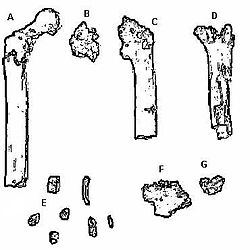Distal-phalanges-comparison-Journal.pone.0011727.g002
Autor:
Almécija, Moyà-Solà & Alba
Přisuzování:
Obrázek je označen jako „Vyžadováno uvedení zdroje“ (Attribution Required), ale nebyly uvedeny žádné informace o přiřazení. Při použití šablony MediaWiki pro licence CC-BY byl pravděpodobně parametr atribuce vynechán. Autoři zde mohou najít příklad pro správné použití šablon.
Shortlink:
Zdroj:
Formát:
956 x 923 Pixel (544361 Bytes)
Popis:
Morphological comparisons of pollical distal phalanges in African apes, extant humans and selected hominins.
Specimens are showed in palmar (top), oblique proximopalmar (middle) and lateral (bottom) views, and scaled to the same length to easily visualize the morphological differences. The main features related to human-like precision grasping are indicated in the middle row, whereas the palmarly protruding insertion for the flexor pollicis longus has been further signaled in lateral view (red arrows in the lower row). Note that, although with several morphological differences, all the features related to refined manipulation in modern humans are already present in the late Miocene Orrorin. By the way, the OH 7 specimen, besides its odd overall proportions, neither shows a distinctive insertion for the flexor muscle, nor a compartmentalized digital pulp. All the phalanges belong to a right thumb. Scale bars represent 5 mm.
Specimens are showed in palmar (top), oblique proximopalmar (middle) and lateral (bottom) views, and scaled to the same length to easily visualize the morphological differences. The main features related to human-like precision grasping are indicated in the middle row, whereas the palmarly protruding insertion for the flexor pollicis longus has been further signaled in lateral view (red arrows in the lower row). Note that, although with several morphological differences, all the features related to refined manipulation in modern humans are already present in the late Miocene Orrorin. By the way, the OH 7 specimen, besides its odd overall proportions, neither shows a distinctive insertion for the flexor muscle, nor a compartmentalized digital pulp. All the phalanges belong to a right thumb. Scale bars represent 5 mm.
Komentář k Licence:
"2010 Almécija et al. This is an open-access article distributed under the terms of the Creative Commons Attribution License, which permits unrestricted use, distribution, and reproduction in any medium, provided the original author and source are credited."
Licence:
Credit:
Almécija S, Moyà-Solà S, Alba DM (2010) Early Origin for Human-Like Precision Grasping: A Comparative Study of Pollical Distal Phalanges in Fossil Hominins. PLoS ONE 5(7): e11727. doi:10.1371/journal.pone.0011727
Relevantní obrázky
Relevantní články
Orrorin tugenensisOrrorin tugenensis je druh vyhynulých hominidů, žijící ve svrchním miocénu na území dnešní Keni ve východní Africe. Vývojově stojí velmi blízko poslednímu společnému předku moderních šimpanzů a lidí a možná již patří přímo k lidské vývojové linii. Pokud je tomu tak, je po rodu Sahelanthropus druhým nejstarším zástupce této větve. Předchází mladším homininům, jako jsou Ardipithecus a Australopithecus. .. pokračovat ve čtení









